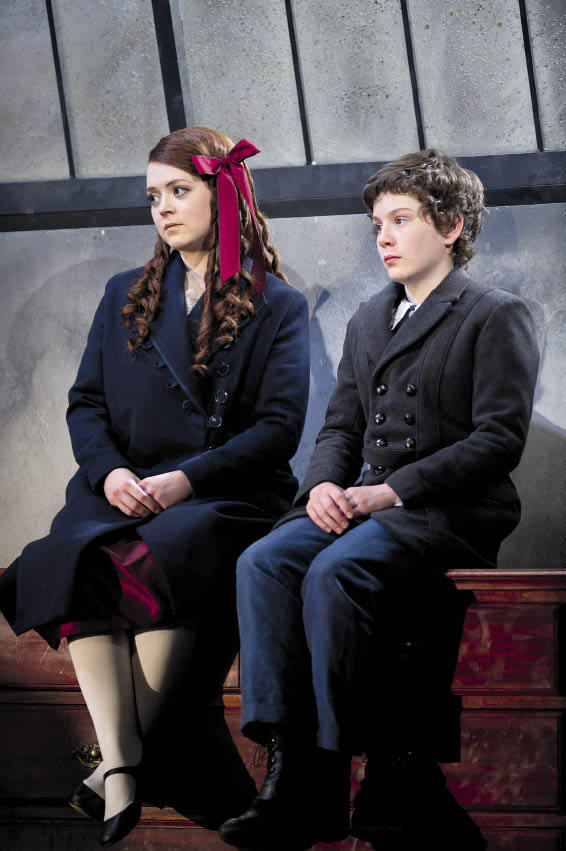The more often I see Britten’s The Turn of the Screw, the more I am bewildered and fascinated by it.
The more often I see Britten’s The Turn of the Screw, the more I am bewildered and fascinated by it. There is no question that it is one of his most brilliant operatic scores, if not the most brilliant of all. One thing that never fails to astonish is the variety of interpretations that the work is susceptible of, both the score and the drama, though of course in a fine production they are complementary — and almost every production I’ve seen has been good. The latest version, from Opera North, is one of the most bemusing so far. About the musical side of it there can be no two views: Richard Farnes coaxes from his 13 players a performance of the most intense refinement, as well as of extraordinary richness. There are passages where he conjures an intoxicating sensuousness from the music, which in the context is unnerving as well as arousing — perhaps just what Britten intended, or would have liked to intend. Last time I heard the score it was under Charles Mackerras, equally masterly but more austere. With Farnes, a languor invades the score whenever possible, whereas Mackerras was urgent and edgy.
Farnes’s interpretation intersects in a complicated and interesting way with Alessandro Talevi’s direction and Madeleine Boyd’s designs: there is only one set, the most prominent feature of which is a four-poster, on which much of the action takes place. Huge semi-opaque windows lour behind it; it’s hard to tell what is reflected in them and what is coming from behind them. The furniture is nursery stuff, including a slightly insulting rocking horse — I mean, these children have graduated to much more sophisticated games than that.
More than in any other production I have seen, this one raises the question of who is enticing and deceiving whom. It’s not long into the opera in this account before there seems to be almost no certainty, except that the ghosts do have an existence independent of the Governess’s imagination — in Piper’s and Britten’s version they are bound to have, since they have a long scene to themselves. Usually, that has seemed to me the least satisfactory part of the opera, partly because it makes them so concrete. In Talevi’s production that is taken a stage further, with Miss Jessel possibly the first pregnant ghost in the history of the genre — presumably she will produce a baby ghost, and there’s no knowing where it will end. This pair, taken by Benjamin Hulett and Giselle Allen, really let rip, and granted that their explicitness is an embarrassment anyway, it may be as well that they do: certainly, I was more struck by the music of their duet than I have ever been before.
Once they are firmly established, there is the question of who knows what, and what they intend to do about it. Here the Governess, a fantastic performance from Elizabeth Atherton, is both neurotic and rightly scared stiff; clearly besotted with the employer she so briefly met, but soon reduced by the apparitions and the sangfroid of the children to a bag of nerves. This pair is terrifying: Fflur Wyn looks much more convincingly a child than Floras normally do, while James Micklethwaite is the best Miles I have ever seen or heard. His bell-like tones go with a knowingness which, at the end of Act I, when, stripped to the waist, he sings ‘I am bad’ to the Governess, as he gets invitingly into bed, is almost monstrously salacious. He is much given to imitation flying, including a weird dance he does to the pseudo-Mozart that Miles should be playing on the piano, but which comes from an ancient horn phonograph; and he is still doing that shortly before the end, when he finally becomes demonically energetic, and then screams his final ambiguous line. All very intense and kind of involving, but as usual the question about Henry James’s tale remains, as it has for more than a century: what is one getting involved in? The question would be less pressing if the tale, and the opera, didn’t at some points get truly unpleasant, as gerontophilia seems to vie with paedophilia to be the centre of attention. But in the end it all seems to be just a frisson. At the performance I went to in Leeds, there was a large contingent of pubescent schoolchildren. It’d be interesting to know what they thought.
English Touring Opera, having covered itself with glory with its production of Goehr’s Promised End, went on to stage The Duenna by Tom Linley and others. Linley, who died in a boating accident aged 22, is one of music’s great might-have-beens. But this work is thin gruel, with far more spoken dialogue than music, and performed on this occasion by people pretending, it appeared, to be puppets. Richard Suart, so brilliant in G & S, tried to turn this into a further work of Gilbert’s, and it fell flat. The ETO Baroque Orchestra had a grim opening night, too, so a lengthy opening night seemed unending.







Comments